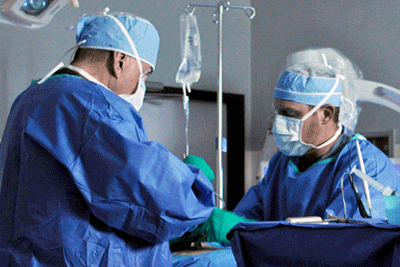Laminectomy & Laminotomy
The Bonati Laminectomy and Laminotomy are decompression surgeries that relieve pressure on spinal nerves caused by narrowing of the spinal canal, known as Spinal Stenosis. This condition may also result in enlargement of the facet joints, stiffening of the ligaments, and bony overgrowth (bone spurs).
While aging (degeneration) is the primary cause of Spinal Stenosis, other conditions that can cause abnormal narrowing of the spinal canal and are commonly treated by Laminectomy and Laminotomy include:

• Bulging/Herniated Disc
As the spinal canal narrows, it presses on the spinal cord and nerves, causing them to become swollen and inflamed. This can result in neurological deficits, pain, and restricted mobility. Additional symptoms of spinal nerve compression depending on the affected area may include:
• Numbness or tingling in the arms, fingers, or hands
• Weakness in the muscles of the arms, shoulders, or hands
• Pain or stiffness in the neck
• Pins and needles or a burning sensation
• Difficulty standing without feeling pain in the back and legs
• Numbness and weakness in the buttocks, thighs and legs
• Discomfort below or above the knee/diffuse leg pain
• Alleviation of pain when sitting or lying down
• Occasional incontinence/loss of bowel control
The Bonati Laminectomy and Laminotomy are performed incrementally, one vertebral level at a time, to address the main cause(s) of pain first. These procedures are performed through a small incision through which a series of tubes patented by The Bonati Spine Institute are inserted. These small tubes accommodate surgical tools and imaging equipment. The lamina is then accessed through an arthroscope, and small portions of the lamina (or the entire lamina) responsible for pressure on the spinal nerves are removed. Bone spurs may also be removed.
The Bonati Spine Institute does not use general anesthesia. Through the use of local anesthesia and conscious IV sedation the patient is comfortable, responsive, and able to provide feedback to the doctors throughout the procedure. This allows our surgeons to target the source of pain with pinpoint accuracy. While in the operating room, the surgical team will confirm the patient is able to complete a series of mobility exercises and verify that the pain has been successfully treated. After the procedure, the patient is transferred to the post-operative care unit for rest and observation, and then a postoperative consultation with the surgeon will help determine if additional procedures included in the surgical plan are necessary. Follow-up surgeries are usually scheduled within a few days of the first surgery, to allow any swelling to subside. During this time, the patient will be given a regimen of walking therapy.
We encourage you to contact us to request a no-obligation MRI review or discussion with one of our medical professionals. Find out why The Bonati Spine Procedures are considered to be among the world’s best solutions for spine problems.
